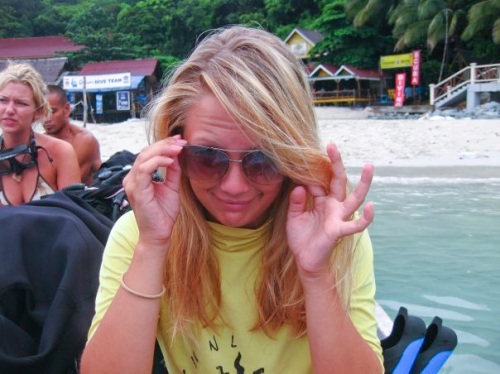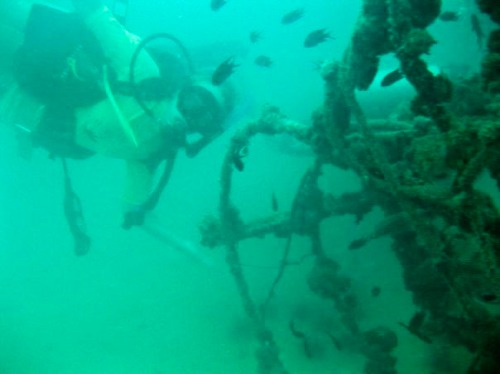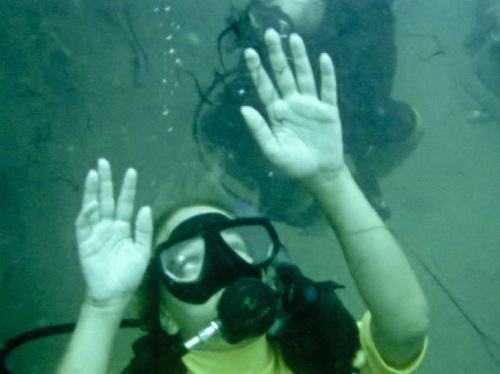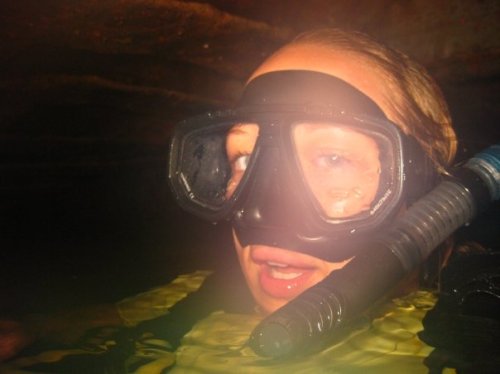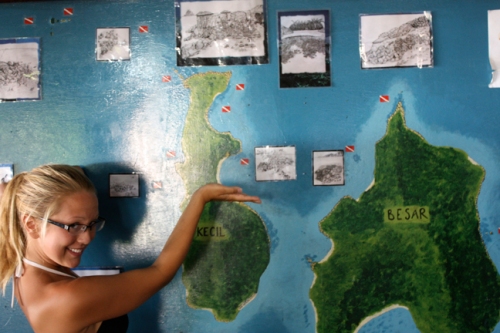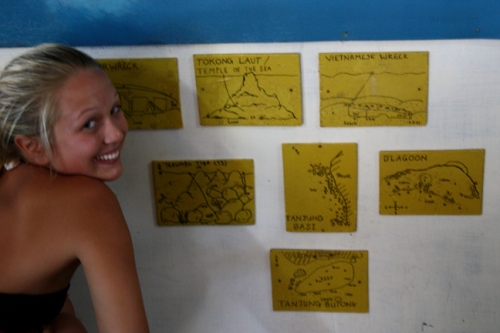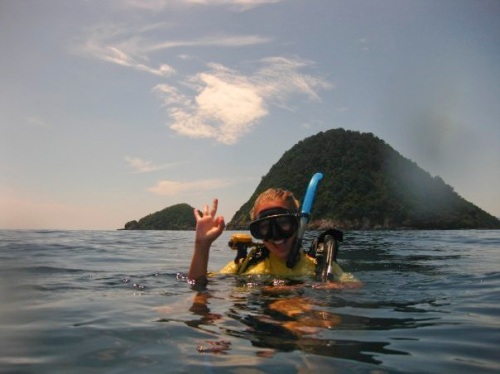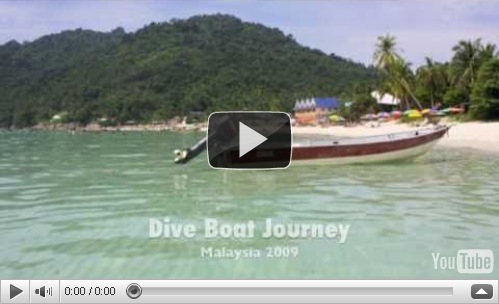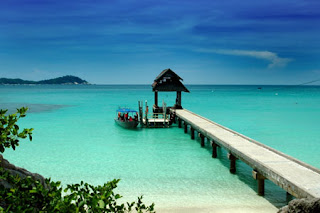Welcome After less than an hour on a boat from the east coast of Malaysia, the laid-back atmosphere and the natural beauty of the Perhentian islands immediately transport you to a different world. The white sand is dotted with sun-worshipping holiday makers, some retreating to the shade for a glass of freshly squeezed juice. A group of scuba divers are boarding a boat to venture out into the turquoise waters and submerge themselves in the underwater wonderland. Later, as the sun sets, a quiet buzz of music and chatter fills the air, together with the thin wisp of smoke from the barbeque fire.
The Perhentian Islands are two islands named Pulau Perhentian Kecil (Small Perhentian Island) and Pulau Perhentian Besar (Large Perhentian Island). The Malay name Perhentian is translated as “place to stop” and this is exactly what these two islands were for traders travelling between Malaysia and Bangkok in years gone by. These islands are still a gorgeous place to stop and rest today, albeit for tourists disconnecting from the stress and routine of everyday life and not for weary seafaring traders.
The islands remain relatively untouched and the only permanent inhabitants live in a small fishing village on Perhentian Kecil. Apart from footpaths that cut through the jungle, there are no roads on the islands. The only way to get around is by walking through the jungle or taking a sea taxi. If you tread carefully, you may even encounter some of the islands’ shy wildlife on the way, such as monitor lizards, fruit bats, squirrels or even the elusive mouse deer. Simple chalets and some moderately luxurious resorts line the picturesque beaches along with restaurants, dive centres and boat operators advertising their services with hand-painted signs.
Perhaps it is the stretches of white beach or the crystal clear water and the superior scuba diving. Perhaps it is the untouched forests or the relaxed atmosphere and unspoiled charm. We like to think that is a little bit of all of this that makes the Perhentian Islands the perfect place to stop and take some time out.
Visit a new place is always a pleasant experience, but things can change if you do not know what is their appeal
Saturday, June 4, 2011
Terantak Amelia Cafe n' Chalet @ Perhentian Island
Friday, June 3, 2011
Perhentian Island Long Beach Self Snorkeling
The Perhentian Islands (Pulau Perhentian in Malay) lay approximately 10 nautical miles (19 km) offshore the coast of northeastern Malaysia in the state of Terengganu, approximately 40 miles (64 km) south of the Thai border. South Beach, Perhentian BesarThe two main islands are Perhentian Besar (“Big Perhentian”) and Perhentian Kecil (“Small Perhentian”). The small, uninhabited islands of Susu Dara (Virgin Milk), Serenggeh and Rawa lie off Kecil. The Perhentians belong to Pulau Redang National Marine Park, which means that fishing, collecting coral and littering are strictly prohibited. Like Besut, people here generally speak Kelantanese Malay. Both the islands have palm-fringed white coral sand beaches (that can be tough on the feet) and turquoise blue sea. One can have a number of activities on its beaches and forests. Scuba-diving, snorkeling, and swimming are the most popular tourist activities here. On most beaches, the water is shallow with lots of rays, cuttlefish and parrotfish. For diving, there are dozens of divesites around both main islands, as well as several off-shore sites. Apart from these, you could also enjoy activities like camping, canoeing, fishing, jungle trekking, and banana boat riding. As for accommodation, most of it can be found around both islands. Hotels are usually aimed at budget travelers. Summer 2007, 2 wind turbines have been installed, nevertheless the island’s electrical power is only available from 7.00pm to 7.00am. For some of the shop …
Thursday, June 2, 2011
Diving in the Perhentian Islands
After days of eye problems keeping us above sea level, we were finally ready to take the plunge. After all, we had come to the Perhentians in part for the virgin reefs fringing the islands.
We dove with the in house dive shop at our bungalow, making it easy to roll out of bed and wade out to the dive boat. On our first diving day we headed out for a two tank trip, hitting two of the island’s most famous dive sites: Sugar Wreck and Terumbu Tiga, or T3. As we headed out my eyes were still a bit sensitive but I was determined to dive!
Sugar wreck was my first ever wreck dive and I was required to complete a PADI “Adventure Dive” in order to do it. The cynic in me says this was a ploy to get me to do my Advanced Open Water course, as it basically consisted of paying more money and pointing to the buoy line a few times throughout the dive. Descending down the line, I was awestruck by the amount of life. Nurse sharks, lionfish and barracuda lurked around the sunken ship ominously, and we swam through the swirling, inky evidence of squid or octopus.
Heading into the wreck, we swam towards an air pocket the divemaster had told us about beforehand. At the time, this was only my seventh ever dive, and my buoyancy control was lacking, to say the least. In my excitement I started to shoot up towards the air pocket, not seeing the metal beam directly in the path of my head. Luckily my dive buddies were a bit more keen than I, and Mark and the divemaster simultaneously yanked me away before any damage was done. Embarassing? Yes. Better than being med evaced off the island? Also yes. My shame evaporated quickly as I marveled at being able to breathe with no air tank, 50 feet under water.
Our next dive was to T3, a favorite site amongst divemasters for its swim-throughs, caves, and microlife known as nudibranches. This was a big day of firsts for me, and lacking any experience with swimthroughs I was so focused on getting through the tunnels and trying not to knock into everything and kill anything, that I have almost no other memories of the dive!
On one of our last days on the island, we headed out for our final dive and what would become one of our best memories of the trip. Tokong Laut, or Temple of the Sea, is the superstar of Perhentian Island diving. Its topography alone would be impressive, an undersea mountain emerging at the surface as only a small blip on the horizon, but below there was more untouched marine life than I have ever seen. I only regret that I didn’t have the diving experience to remember the names of what I was looking at or the camera skills to capture it! (All underwater photos in these posts are taken with the borrowed camera of a friend, and we really didn’t know how to use it very well.) What I can remember is Mark and I looking at each other underwater, seeing the excitement in each others eyes, and signing frantically to each other over the magic of it all. We were even lucky enough to see the resident three legged turtle that we had been briefed on! It was my first time seeing my blog’s namesake underwater, and it was love at first site. Even with my limited technical skills and inexperience, to this day this is one of the best dives of my life.
Keeping with my recent video clip theme, I put together a short video of our boat ride back to the dock. My camera skills weren’t what they are today, but you can get an idea for the amazing topography of the Perhentians. At the end of the video we pull right up the bungalows we were staying in. Enjoy!
Wednesday, June 1, 2011
Pulau Perhentian Kecil and Besar
The Perhentian islands are surrounded with pristine waters and white sand beach. In fact, Pulau Perhentian is made up of two islands named Perhentian Kecil and Perhentian Besar. It is located at Terengganu in Malaysia and there are direct flights from Kuala Lumpur to Terengganu. From there you can take a bus to Kuala Besut and get on a ferry to Pulau Perhentian. Do note that there are no ATMs, banks and public phones. The prices on both islands vary from time to time because of the low and high season. Now’s the time to disconnect from the outside world.
Perhentian Kecil
Kecil means small in Malay and this part of the island is known for backpackers. The vibe is pretty laid back and has a party atmosphere when dusk sets. The island is mostly frequented by backpackers from Europe, America and Australia. There are several cheap accommodations at Perhentian Kecil. There are several eateries and bars on the main beach, Pasir Panjang. It can get a little loud at night so best to stay somewhere that is secluded on Perhentian Kecil if you want some privacy. Although most accommodations are minutes away to the sea, the view is not as spectacular as Perhentian Besar’s.
Pasir Panjang (also called Long Beach) is the main beach and has a crescent shape coast ideal for swimming, snorkeling and diving. There are less corals on the furthest left side of the beach. Bring a book or a beach ball to enjoy the view of South China sea. Take a water taxi to Perhentian Besar if you want to explore the other island.
Perhentian Kecil has accommodations that is also part of a diving centre. The waters is known for diving and snorkeling therefore get an accommodation that comes along with water sports package. PADI diving course is also available at most diving centers. You can opt for jungle trekking as there are trails so you won’t get lost. Bring along an insect repellent and a bottle of water.
Seafood is the main cuisine found on Pulau Perhentian. Perhentian Kecil offers ala-carte eateries, mostly along Pasir Panjang. You can try local dishes such as Mee Goreng and quench your thirst with an ice cold lemon tea for less than MYR10. The prices at Perhentian Kecil is way cheaper than Perhentian Besar.
Perhentian Besar
Besar means big in Malay and it is upscale than Perhentian Kecil. Most of the resorts are located on the western part of the island. The other part of Perhentian Besar is undeveloped and surrounded with dense forests. If you are seeking quality time and privacy with your loved ones, book an accommodation that is away from the other resorts. The island is mostly frequented by families with children.
There are two beaches at Perhentian Besar named Teluk Pauh and Teluk Dalam. The beach at Teluk Pauh is a giant pool with crystal clear waters. Swimming and lazing on the beach are the perfect activities for an island holiday. Sign up for a diving or snorkeling package to try something different once in a life time. The other beach is Teluk Dalam and it is the longest beach on Pulau Perhentian. The waters are not as clear as the previous beach but the location is a little far off from the resorts. If you are lucky, the beach is empty and you can play a game of volleyball or lie on a sarong to get a tan.
All resorts on Perhentian Besar has an in-house restaurant and bar so no worries about food when you are there. Do note that there no ala-carte eateries here. If you want to try authentic local dish, get a taxi boat booking from the resort.
Pulau Perhentian suits anyone who is looking for new experience or a quiet solitude time. Pick Perhentian Kecil if want to chill and party and Perhentian Besar for privacy and peace. The best time to visit is in March and early September.
Tuesday, May 31, 2011
Perhentian Islands
Saturday, May 28, 2011
Sabah may be the first state to ban shark hunting

Image sabahtourism
The beautiful Malaysian state of Sabah will set a good example if this new shark hunting ban law is enforced.
Kudos to the local government to have the environment in mind which makes perfect sense as besides realising the importance for maintaining the future populations of wildlife, the natural wonders of Malaysia is also a top selling point for Malaysia.
Though some statements such as “sharks no longer exist in Peninsular Malaysia” is inaccurate, their intentions should be applauded and sets a good example. They should however look into how a catch and release law can be implemented, even for other fishes, like how the Bonefish is protected for example in Florida. Game fishes can be worth more alive than dead in many cases, some much more. Just look at the numbers of sport fishermen that spend tons of money going overseas to fish, and then return their catch back into the waters to see them swimming away.
Another notable effort by them was the Tagal system encouraged years ago to create no-take zones of fishes in freshwater rivers. I hope the system is still going strong.
It’s time those put in charge realise that shopping is NOT a major attraction of Malaysia. Neighboring Singapore and Thailand does a MUCH better job at that.
KOTA KINABALU: Sabah is likely to be the first state to ban shark hunting for their fins in a bid to protect the marine creature.
The state government is now studying the legal aspects of the proposed ban – which would require amendments to the State Wildlife Protection Ordinance – with the aim of introducing it by the end of the year.
State Tourism, Culture and Environment Minister Datuk Masidi Manjun said the situation was becoming critical for this marine creature as only 20% of its original population was still left in the country.
“From my last briefing, there are only four areas in Sabah where sharks can be spotted.
“If we don’t do something about it, the population may disappear from our waters completely,” Masidi said yesterday.
Masidi said he was told by experts that the sharks no longer existed in peninsular Malaysia waters.
He said the state attorney-general was now studying the matter.
He added that the state government was working with non-governmental groups to educate the public on the need to protect sharks from “disappearing” entirely.
“We understand the sensitivities involved as it is a must for some people to serve shark fin soup during weddings. But what we are trying to do is to educate the people to skip the dish for conservation’s sake,” he said, adding that it would also get Malaysia Airports Berhad to bar retailers from selling shark fins in airports in the state.
The state government, he added, had also taken shark fin soup off the menu of its official functions.
Friday, May 27, 2011
For Exciting Scuba Diving, Malaysia Is An Ideal Destination
Borneo is a sovereign state made up of parts of Malaysia, Indonesia, and Brunei. An island set north of Australia in the South China Sea, Borneo offers miles and miles of coastline from which boats launch daily for some of the world's best scuba diving. Malaysia is known for lush rain forests and calm, warm waters, giving divers and other tourists a delightful opportunity to enjoy new experiences in this beautiful area.
With so many coastal towns and villages, it is no wonder that scuba diving is such a booming business. Diving in Malaysia is an ultimate goal for many enthusiasts, and dive sites dot the areas around the island. Just a short boat ride away is the Tunku Abdul Rahman National Park, which consists of a series of five islands, around which divers enjoy shallow diving in the calm, safe waters of the South China Sea. Beautiful reefs and fantastic sea life abound to the delight of those who wish to partake.
If you are visiting Malaysia, and have never tried diving before, you will find that this is a great place to try. Diving centers offer dive equipment for beginners and experts alike. Mares, a leader in diving equipment, is stocked widely throughout the island. Of course, these diving centers are not just for shopping. Rent a boat for the day, which will come with a captain and a first mate who know the waters and will take you to the most rewarding dive sites. Rookies can find diving instructors who will first guide them through the scuba shop to ensure they have the right gear; then they will go out with them for instruction and coaching.
If you are planning a trip to Malaysia, and diving is a priority for you, consider one or more of the following cities: Sipadan Island, Mabul, Kapalai, Layang Layang, and Lankayan. Each offers outstanding diving opportunities, as well as beautiful surroundings, and comfortable accomodations.
Less than an hour from the mainland of Borneo is Sipadan Island, which, for some, is the ultimate site for diving. Multiple big and small fish populate the waters near the island, as well as sea turtles and sharks. Just a short trip north of this island is Mabul, which offers the finest in macro diving. This form of diving involves the use of a macro lens camera to examine and photograph very small sea life. Kapalai is an island resort near Sipadan Island, which is an ideal site for a vacation, even if you have no interest at all in diving; however, divers will be treated to a show when they observe squid, needlefish, and mandarinfish at home in the waters surrounding the resort.
A dive shop is available on each island and in every town to ensure that you have everything you need for your expedition. If you have never tried this popular sport and pastime before, but are curious about scuba diving, Malaysia is one of the most beautiful and rewarding places in the world that you can try.
Thursday, May 26, 2011
Sabah, the Malaysian Borneo

Sabah is a beautiful island nestled in the northernmost portion of Borneo. It is one of Malaysia’s thirteen states wherein it ranks second in as far as land area is concerned. Other than Sabah, Borneo also plays host to Indonesia’s Kalimantan and Brunei.
Sabah is a haven for discerning travelers who are in the lookout for the most diverse ecosystem and extreme fun. Tourists will love this place for its warm people, diverse culture and the most mouth watering local cuisines. It is also where you can find Rafflesia, the world’s largest flower. It has the famous dive site in Sipadan Island and the most tricky mountain slope in Mount Kinabalu.
Sabah does not only boast of its exotic wildlife tours but of its colorful culture too. Its people are known for their heartwarming hospitality and vibrant personality. To a tourist, the most unforgettable part of the trip is by being greeted by the most sincere Sabahan smile.
Wednesday, May 25, 2011
Sharks in Sabah Are Going Extinct
Attended a talk about sharks by Prof Steve Oakley from The Green Connection at The Sabah Society last Thursday.
If you knew how shark's fin was harvested, would you still eat that bowl of shark's fin soup?
The fins are chopped off when the shark is still ALIVE and the shark is then thrown back into the sea to make room for more fins (more valuable than shark's meat).
What do you think happens to the shark later?! They can't freakin' grow back a new fin can they? The sharks are unable to swim normally and either suffocate or get eaten by other fish. Can you imagine the waste?
Here are pictures by someone called Dicky Ho who encountered a dying baby whale shark.


Whale sharks are huge, harmless, plankton-eating sharks in the sea. And this one was just a baby. Next time you see shark's fin on the menu, remember what the shark went through to give you that 'dish'.
Malaysia is the 10th highest shark-hunting country. How is this possible you ask when there are barely any sharks left Malaysia? Most of it is caught by deep sea fishing vessels that even sail as far as Hawaii.
Sharks can only be spotted by divers in the deep sea of Borneo now and only in the shallow waters of Lankayan and Sipadan island in Sabah. I have never seen any sharks in Mengalum (KK area) aside from the migrating whale sharks that visit every year. There are no more sharks left in the peninsular.
Sharks keep our seas healthy and balance our ecosystems. They generate thousands of $ for the tourism diving industry. Tourists are not paying $ to see finned sharks at the fish market.
Do sharks a favour before it is TOO LATE!
Tuesday, May 24, 2011
Mabul Island Dive Resort
Borneo Divers Mabul Dive Resort, Mabul Island, Pulau Sipadan, Sipadan Island, Sipadan, Pulau Mabul, Mabul Island, Tawau, Semporna, Sabah, Malaysia, Borneo, Sipadan Water Village. Sipadan Mabul Resort is located at the southern tip of Mabul Island overlooking Sipadan. Dive Discovery offers dive resorts, scuba diving vacation in Malaysia. Welcome to Sipadan-Mabul Resort - Luxury Beach Resort located on Paradise Mabul Island next to Sipadan island. 5* PADI TEC Dive Center - Dive Sipadan with SMART Divers. Sipadan Scuba Diving Malaysia at Borneo Divers Mabul Island Resort Mabul Water Bungalow is a new floating dive-resort wholly owned by Sipadan-Mabul Resort (Sabah) Sdn. Borneo Divers Mabul Dive Resort, (reservations@borneodivers.info), [8]. edit How to Dive Mabul For environmental reasons this tiny island has now closed its resorts. Lists information on muck diving, accommodation descriptions and rates, along with contact details. Mabul is a small sandy island with coconut trees, dive resorts and a local fishing village, and only 25 minutes or so from Sipadan itself. Accommodation is made from native materials of Borneo and is on a twin share basis. Based in Kota Kinabalu, with information on local dive conditions and sites, downloadable videos, details on bookings, photos, contacts, travel tips and suggestions.
Sipadan Water Village Resort with beautifully constructed water cottages, located at Mabul Island, Sabah, Malaysia, offers PADI courses, diving/snorkeling activities & a romantic. There are several dive resorts operating on Mabul island. Dive Resort beckons divers for a taste of the ultimate in dive. This means the best way to dive here is by staying in on one of the nearby resorts at Mabul. Mabul is arguably one of the richest single destinations for exotic small marine life anywhere in the world. Accommodation is made from native materials of Borneo and is on a twin share basis. On Mabul Island, a tropical island home to a marine ecosystem that offers some of the finest diving in the world. Bhd. (SMART), is situated at Mabul Island overlooking the world. Welcome to Sipadan-Mabul Resort - Luxury Beach Resort located on Paradise Mabul Island next to Sipadan island. 5* PADI TEC Dive Center - Dive Sipadan with SMART Divers. Mabul Island (Pulau Mabul in Malay) is a small island off the south-east coast of Sabah in. Sipadan Mabul Resort is located at the southern tip of Mabul Island overlooking Sipadan. Sipadan / Kapalai Diving - Your Sipadan, Kapalai, and Mabul Dive Resort Specialist. Mabul Water Bungalows is a new floating dive-resort situated at Mabul Island overlooking the world-known Sipadan Island which is 15-minutes away by speedboat.

Saturday, May 21, 2011
ABOUT Air Pollution Index Ministry-Web Tidal Forecast Lake needs to be taken care of
Escherichia coli, popularly known as E.coli, is undoubtedly the organism of the week, no thanks to its mention in the same breath with Tasik Kenyir.
EARLIER this week, the Terengganu state exco member for tourism Datuk Abdul Rahin Mohd Said was reported in two Malay dailies as saying that an ongoing research by Universiti Malaysia Terengganu (UMT) revealed that the level of E. coli in the lake had been rising, and that it was at a worrying level (Rahin denied the media reports a day later).
Whatever the case, the hoohah over E. coli, also known as faecal coliform, arose from a water sampling study that was meant to assess the health of Tasik Kenyir for aquaculture, which has been ongoing for more than 10 years.
Lead researcher Prof Dr Faziah Sharom of UMT’s Institute of Tropical Aquaculture (she is also the director) told the media that her study, due to be completed next month, looked at the effect of E. coli levels on aquaculture (there are lots of caged fish breeding in Kenyir) and not on humans.
 State jewel: Besides attracting tourists to its beautiful surroundings (top), Tasik Kenyir is also used for caged fish breeding (below).
State jewel: Besides attracting tourists to its beautiful surroundings (top), Tasik Kenyir is also used for caged fish breeding (below).
In 2006, some 2,800ha of the 37,000ha man-made lake were set aside for fish breeding using the cage method. There were three fish breeders operating on a commercial scale at that point, and Tasik Kenyir is the mainstay of Terengganu’s freshwater fish production, contributing the bulk of its 10,000-tonne-a-year output.
“Our preliminary survey indicates that the E. coli levels in the water do have a negative effect on the fish population, and we know that the bacteria come from sewage,” she said. She did not reveal the actual readings.
The Interim Water Quality Standards for Malaysia (INWQS) is applicable to freshwater bodies like lakes, streams and rivers. INWQS has five classes, from I to V, with Class I being the best and Class V being the worst. A certain amount of faecal coliform can be expected in the most pristine stream, and as such, Class I allows for up to 10 counts of faecal coliform per 100ml of water sample drawn.
For the cultivation of sensitive aquatic species, the water should not be worse than Class IIA (maximum of 100 counts of faecal coliform per 100ml). When primary contact with water is involved (swimming, waterskiing or wakeboarding), the water should not be worse than Class IIB (limits faecal coliform to 400 counts per 100ml).

The United States Environmental Protection Agency recommends a limit of 235 per 100ml for recreational waters.
However, when looking at the bigger picture, it seems that E. coli’s name is worse than its bite. Save for one or two strains, which can wreak havoc in our gastro-intestinal system, E. coli by itself is generally quite harmless.
But because it is present in high numbers in the gastro-intestinal tracts of vertebrate animals (including humans), it serves as a good indicator of the severity of faecal pollution in any water body.
Or put in another way, if lots of E. coli are found in a pond, chances are high that there is a lot of faecal contamination there.
Faecal contamination is not to be taken lightly as human faeces carry pathogens such as enteroviruses (including the Coxsackie virus), noroviruses, hepatitis viruses, Shigella spp. and Salmonella spp.
 Tourist attraction: A boathouse taking guests around Tasik Kenyir in Hulu Terengganu.
Tourist attraction: A boathouse taking guests around Tasik Kenyir in Hulu Terengganu.
Whatever the actual E. coli levels are, Rahin said UMT’s report of the lake being contaminated was hardly surprising as boathouses without a proper sewerage system had been allowed to operate there for the past 10 years.
Total absence of a sewerage system would be a more appropriate description, as nearly all of them discharge waste from the toilets directly into the lake. There are currently 30 to 40 of such boathouses, each capable of carrying 10 to 15 passengers. Typically, these boats will anchor in good fishing spots for at least two nights.
Besides the boathouses, there are a few land-based resorts around Tasik Kenyir. Each is believed to operate its own private sewage treatment plants (Indah Water Konsortium Sdn Bhd confirms it does not have any customers in the Tasik Kenyir area).
Even in this case, the current Malaysian standard for treated effluent discharges from sewage treatment plants (STPs) does not prescribe any parameters for faecal coliform (it does set limits for biological oxygen demand, chemical oxygen demand, oil and grease, total suspended solids, as well as ammoniacal nitrogen).
“Given this, no STP owner, whether IWK or private operators, is legally required to incorporate disinfection measures (eg. clorination or ultraviolet treatment) before discharging the final treated effluent into the lake, river or sea,” said Assoc Prof Dr Maketab Mohamed, a water quality specialist from the Chemical Engineering Department of Universiti Teknologi Malaysia’s Faculty of Chemical Engineering.
In an e-mail reply, the Kenyir Lake Resort & Spa, arguably the largest resort in the area, declined to comment on the E. coli issue beyond saying that “we believe our house is in order”.
Sustaining the environment
The director of Terengganu’s Department of Environment could not be contacted for comments on the overall state of sewerage infrastructure in the state. However, those familiar with the tourism trade revealed that it had taken a long time for sewerage infrastructure in two of the state’s crown jewels, Pulau Redang and Pulau Perhentian, to move in the right direction.
“I estimate that it is only recently that about 80% of Redang’s resorts, mostly around the Pasir Panjang area, are connected to some form of sewerage treatment facility. As for Perhentian, it still has a long way to go,” said Alex Lee, managing director of Ping Anchorage Sdn Bhd, an award-winning tour operator which specialises in Peninsular Malaysia’s east coast attractions.
Lee said most of the smaller operators on the resort islands needed a lot of guidance and push from the Government as they either lacked knowledge, motivation, or funds to set up proper sewerage infrastructure. “Getting them to think green and sustainable is a huge challenge in the next few years,” said Lee, who also highlighted that the islands’ coral reefs were suffering from severe degradation as well.
“Kenyir will continue to see a rise in visitors given the many developments planned for the area, like turning it into a duty-free zone. All these are good, but we should get our fundamentals right first, like a proper waste and sewage disposal system, otherwise the developments will not be sustainable in the long run.”
To its credit, the state government is doing something about the problem, even if the initial attempt seems rather crude.
“Based on our survey, we will install a wastewater capture system without charge to the existing 37 boathouses,” Rahin said on Monday at the launch of the Kenyir Cup 2010 fishing competition at Pengkalan Gawi.
He said the state had allocated RM103,000 for that purpose, or an average of RM2,800 per boathouse, though it remains unclear whether these are actually on board septic tanks (which means there will still be some discharge of treated or partially treated effluent into the lake) or wastewater holding tanks, which means that there will be absolutely no discharge allowed into the lake (all wastewater has to be pumped ashore for treatment).
If Tasik Kenyir is in California (where it will most likely be gazetted as a zero-discharge zone), all boats and boathouses will be required to store sewage on board, and to dump these only at designated pumpouts located at various points (see www.dbw.ca.gov/Environmental/pumpinfo/Default.aspx).
At the same function, Rahin said 18 boathouses (those used for Kenyir Cup 2010) were now equipped with “septic tanks” while 19 others were awaiting their turn to be fitted with the tanks, each with a 200-litre capacity.
A boathouse operator, while welcoming the move, said the capacity of the tank could turn out to be “impractical” as it could only hold half-a-day’s worth of wastewater. On a per capita basis, Malaysians easily consume more than 200 litres of water per day.
On Wednesday, Health Minister Datuk Seri Liow Tiong Lai said his ministry planned to take water samples to check the levels before deciding on the next course of action.
“It is common for E. coli to be present in lakes like Kenyir but the levels are usually low,” he said.
Regardless of the finding, Kenyir faces more threats than just untreated sewage discharges. Simon Lum, from Melbourne, Australia, who recently spent a long weekend with a few friends on a houseboat, was disturbed enough to write to The Star: “On that weekend, there were no less than 14 houseboats with an average of 10 people on board, all berthed around the Sungai Cacing area. Is there a limit to how many people can visit Kenyir at any one time? My boatman told me there could be as many as 18 to 20 boathouses at one time.
“Over-fishing is very evident. There is no limit to the size (or) number or species of fish that are landed. Traps were being laid, too. Even our boatman brought in lots of baung, large and small, from a trap that he had laid. Our group hooked a variety of fish, including the beautiful belida and kelisa. We released the kelisa, which we believe to be an endangered species, though the belida died from the fierce struggle it put up.
“The boathouses have no proper sanitation. Everything is flushed into the lake. Food leftovers are tossed into the water, and water is drawn from the lake for cooking and washing! The park rangers were supposed to check for live fish being taken out but as we berthed the boat at the station on our way out, an official from atop the hill waved us through. I am told that the Government is proposing to turn Tasik Kenyir into a duty-free zone. I fail to see the logic of it as I believe Tasik Kenyir should be protected from further destruction. I hope to visit Kenyir again in five years and pray that it will thrive both as a sanctuary for local freshwater fish and a tourist destination.”
Friday, May 20, 2011
Ulik Mayang Spa @Lake Kenyir Resort & Spa
Situated right on the water edge, Ulik Mayang Spa is one of the best-located buildings in the resort. In Malay, Ulik means to sing or murmur in a soft, calming way while Mayang is tied bunches of coconut blossoms that are mainly used in traditional Malay treatment as a medium to free your mind and soul from evil spirits. Thus, Ulik Mayang Spa as the best place for you to ease away your physical, emotional and spiritual stress with a variety of traditional range of spa treatments & massages.
Thursday, May 19, 2011
Kenyir Lake (Tasik Kenyir)
Kenyir Lake (or “Tasik Kenyir” in Malay/local language) is the largest man-made/artificial lake in Southeast Asia and it is located Terengganu, Malaysia. It was created in 1985 by the dam up the Kenyir River with the construction of Sultan Mahmud Power Station.
Kenyir Lake with the area size of 369 sq. km is Malaysia’s biggest rock-filled hydroelectric dam too. Kenyir Lake is seperating Pahang in the South and Kelantan in the west. Kenyir Lake also serve as the gateway to another Malaysia favourite tourism location, Malaysia’s National Park.
Kenyir Lake is the place for large number of animal and species of strikingly strange wildlife and freshwater fishes. Below are some of the statistic and detail of Kenyir Lake:
| State | Terengganu |
| Islands | 340 |
| Water fall | > 14 |
| Water Catchment Area | 38,000 hectares |
| Fish Species | big Barboides (Lampam Sungai), Snakehead (Toman), Friendly Barb (Kawan), Giant Gouramy (Kalui), Green Arowana (Kelisa) and Malaysian Mahsee (Kelah) |
| Endangered animal | Malaysia tiger, Asiam Elephants |
| Recommended Activities | Fishing, watersports, canoeing, kayaking, rafting, boating, bird watching, cave exploration, shooting, and jungle trekking. |
Wednesday, May 18, 2011
Kenyir Lake, THE lake of Malaysia…; Part IV of Terengganu road trip

Lake Kenyir is huge
Kenyir Lake (Tasik Kenyir) is THE lake of Malaysia I would say. This man made lake in Malaysia had me going back almost every year since the first time I visited it back in 2005 probably. Since then, I have been back to the lake many times over, fishing, camping or just plain relaxing. It really is a place to just get away from it all and relax.
This visit is no different. The lake itself looks as if time has stood still. Its beauty is just mesmerizing. John, upon seeing the lake for the first time froze as he soaked up the scenery. “Keong…this place is different. No where close to Lake Temenggor or Lake Bera (L:INK). I know now why you like this place so much”.
Yup, this place is awesome. It is different. Freshwater all around and it’s jungle is pristine. It will make you want to stay and never leave the place (well, it’s the case for me at least). There are many things to do at this lake. Besides its numerous attractions like waterfalls, caves and hilltop islands, this place is a great place for fishing and nature appreciation trips as well.

Kenyir’s island are actually hittops, they emerged after the water has flooded the entire area

Some trees are still standing even after the place has been flooded
There are a few ways to get to Lake Kenyir. Of course driving your own vehicle there would be the best option. Driving will give you the flexibility of just stopping anywhere, whenever you want.
But if you have to take public transport, the nearest town to Pengkalan Gawi jetty is Kuala Berang. The only buses that goes directly into Pengkalan Gawi jetty (Lake Kenyir’s entry point) as far as I know comes from Kuala Lumpur, Putra bus station near PWTC. You will have to check the bus operator though, trips are on certain days and not frequent.
From other parts of Malaysia, try to make your way to Kuala Berang and from there take a cab. Alternatively, fly into Kuala Terengganu and take a cab in. But from Kuala Terengganu’s airport to Pengkalan Gawi would be more than an hour’s drive, so be prepared to pay for the cab ride.

Boat ride on Lake Kenyir
While making your way there seems like a challenge, it is all worth the effort I guarantee. Kenyir lake is magnificent, charming and irresistible.
Tuesday, May 17, 2011
M'sia's Lake Kenyir now a duty free zone
State government to inject a fund of S$42.7 million for makeover of Kenyir and make it into a top holiday destination.

KUALA TERENGGANU - Tasik Ken-yir, the largest man-made lake in South-East Asia, has been officially declared a Duty Free Zone (DFZ).
Terengganu Mentri Besar Datuk Seri Ahmad Said said this was confirmed through an official letter dated Sept 21 from the Finance Ministry.
"The state government will inject an initial fund of RM100mil for the makeover of Kenyir.
"We will ensure that the DFZ is a catalyst for the development of Kenyir which has been neglected for the past 30 years," he told reporters after chairing the weekly state exco meeting here yesterday.
Ahmad said Kenyir would be turned into a top holiday destination over the next two years and the state government would woo local and foreign investors, especially manufacturers of branded attire, watches, shoes and other consumer products to set up outlets.
"We will also host a myriad of international events in Kenyir from now on," he added.
Kenyir, Ahmad noted, was blessed with 340 islands while being rich in flora and fauna, but there had been no aggressive promotions to turn the area into a popular tourist destination.
"The Terengganu government hopes the DFZ will act as an impetus for the growth of eco-tourism in the area," he said.
Proposed developments include the construction of hotels and chalets, a theme park, orchid garden, fruit orchard as well as bird and butterfly parks.
Kenyir will also be turned into a shopping paradise, catering to both high-end holidaymakers and shoe-string travellers.
Ahmad said a duty-free complex, shophouses, condominiums and Customs Department complex would also be constructed in the next two years.
He said the state government would call for a tender today for the laying of RM33mil electrical cables to Pulau Bayas in Kenyir so that the island could be developed for tourism.
A Setiu-based environmentalist, Dr Azman Ibrahim, meanwhile, urged the state government to carry out an environmental impact assessment before going ahead with the plan.
The rich eco-system in the Kenyir area should not be compromised, although the plan could turn it into a revenue spinner for the state and the local community, he said.
Dr Azman said the state government should not ignore that the man-made lake was home to more than 8,000 species of flowers, 2,500 species of plants and trees as well as more than 300 species of freshwater fish.
Any physical developments in areas edging the lake could contaminate the water, he said
Saturday, May 14, 2011
Special feature: Tanjung Rhu Resort, Langkawi, Malaysia
We hadnt been to Langkawi island before, although weve been to Malaysia many times. Langkawi is an amazing place and the Tanjung Rhu Resort is ideal for getting away from all the stresses of modern life.
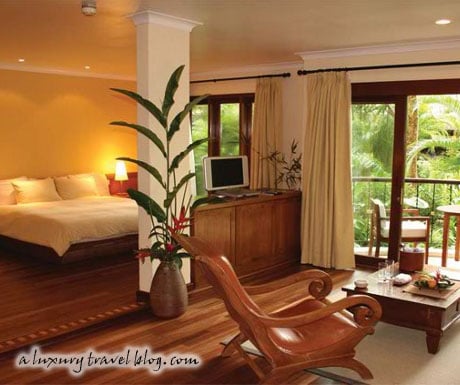 There are several ways to get to Langkawi. We tried two different methods of coming and going. First we flew into Langkawi from Kuala Lumpur the flight takes about an hour. At the end of our stay we left by going on the ferry to Penang. The small catamaran was absolutely fine for us but Id not recommend it for anyone who gets seasick. The journey takes about three hours and if the sea is a bit choppy, which it was on the day we travelled, then be prepared for a bumpy ride. The resort was very efficient about organising transport for our pick-up from the airport and drop-off at the jetty.
There are several ways to get to Langkawi. We tried two different methods of coming and going. First we flew into Langkawi from Kuala Lumpur the flight takes about an hour. At the end of our stay we left by going on the ferry to Penang. The small catamaran was absolutely fine for us but Id not recommend it for anyone who gets seasick. The journey takes about three hours and if the sea is a bit choppy, which it was on the day we travelled, then be prepared for a bumpy ride. The resort was very efficient about organising transport for our pick-up from the airport and drop-off at the jetty.
The Tanjung Rhu Resort is situated at the north east of Langkawi, where the islands best beaches are. And Tanjung Rhu has more than two kilometres of private beach! Most of their beach is tranquil but they also have an area set aside for activities such as volleyball and soccer. Theres so much going on at Tanjung Rhu that their activities merit a separate article.

On arrival, we were greeted and shown to our room for check-in. Its so much nicer doing the check-in process in your room rather than at a hotel reception desk. We were given cold drinks and there was also a bowl of fruit for us. The bowl was replenished every day, and also every evening the turn-down service provided us with luxury chocolates.
The room was! spaciou s and very well furnished with a comfortable sofa, coffee table, a big flat-screen TV, a DVD player, and a bed of course. The bathroom was huge, with an oversized bath, two wash hand basins, a separate shower cubicle, and a WC cubicle. The toiletries provided were beautifully presented in environmentally friendly packaging.

There was also a small balcony with two chairs and a table. This was very comfortable both for snacking and for being able to use our computers outside. The resort offers complimentary WiFi throughout so this was very handy indeed, as it enabled both of us to go online at the same time. For those who dont take their own computers everywhere with them, the resort also provides two private booths where guests can go online using the resorts computers, which are equipped with printers in case you need to print anything out.
During the check-in process we were given an attractive map of the resort to help us get oriented. As well as the guest accommodation, there are several public areas for guests to eat, drink, and play, or just sit quietly enjoying the superb views of the white sandy beach facing the Andaman Sea.
The resort has three swimming pools:
Sands Pool an ozonated (chlorine free) 50-metre swimming pool for adults only

Sunset Pool a 60-metre designer pool facing the horizon

Lagoon Pool a salt water pool shaped to emulate a natural lagoon

There are also three restaurants: The Sands an all-day dining venue; The Saffron a trendy Mediterranean style eatery; and The Rhu the resorts fine dining restaurant. Again, the options for eating at the Tanjung Rhu deserve a separate article.
For those who like being pampered there is the award-winning Jiva Rhu Spa, which offers a wide variety of treatments. Jiva is the Sanskrit word for life and the treatments leave you relaxed and ready for everything life offers. Most of the treatments are derived from traditional Eastern traditions dating back thousands of years and given a contemporary take. You can choose from Thai, Malay, Balinese, and Ayurvedic treatments as well as reflexology and aromatherapy.

The resort also has a Reading Room where you may sit quietly and read over tea or coffee, or borrow DVDs from their library to watch back in your room. The Reading Room has big picture windows offering the most perfect sea view.
As you can see, the resort has everything for those seeking tranquillity and, as youll also see from my next articles about leisure activities and dining at the Tanjung Rhu, theres lots to do. However, its worth a mention that the resort does not only cater to holidaymakers. You can also do business in this amazing environment. The Pavilion Meeting Room can accommodate from 45 to 100 people and offers teleconferencing, as well as state-of-the-art audio and video facilities. Theres also a lounge, which is a good place to have pre-meeting drinks. What a fantastic way to do business.

Finally, its definitely worth mentioning the staff. The staff w! ere trul y excellent. They did everything they could to ensure the comfort of their guests, and I really couldnt praise them highly enough.
All in all, if youre planning a luxury holiday in the Far East I suggest you look a bit further than the usual well-known haunts and give the lesser-known Langkawi a try. And if you do decide to visit Langkawi, then where better to stay than the Tanjung Rhu Resort?
Sponsor Links
Click Here!Complete Niche Travel Package! Make Money In Travel!Best Deal Ever
www.nichetravels.com
Click Here!Travel Blog Success - eCourse
travelblogsuccess.com
Click Here!A Second Home In New Zealand
www.nukiwi.com

